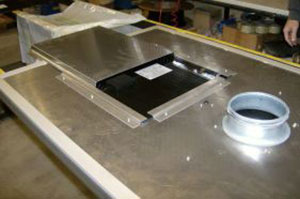Learn more about the advantages of the SolarVenti ventilation, dehumidification and heating system
Operation
During normal operation, the solar air collector gets started as soon as the sun shines. – The sun’s rays shining from the North will generate electricity in the solar cell, which will then get the fan to run. The fan will pull fresh air through the back plate and absorber felt – inside the solar panel. The air will be warmed up and blown into the house.
On hot summer days, you will not need extra heating. Here have a choice – you can turn off the system and thanks to SolarVenti patented back panel, the collector is able to cool itself, so there is no overheating. The second option is to turn the fan speed on to high for more air flow and greater dehumidifying in turn reducing the humidity lower than ambient making the comfort level greater. SolarVenti is the only air collector on the market that can cope with passive cooling even under extremely sunny climates.
Thermal Comfort
There are six factors to thermal comfort and a Solarventi air collector can meet four of these factors. The six are namely metabolic rate, clothing, air temperature, mean radiant temperature, air movement and relative humidity. Thermal comfort is the condition of mind that expresses satisfaction (feeling) with the thermal environment and is assessed by subjective evaluation (ANSI/ASHRAE Standard 55).[1] Maintaining this standard of thermal comfort for occupants of buildings is the ‘way’ for a Solarventi solar air collector.
For the use on hot summer days you may add an extra fan blowing tempered air in from the shadow side of the house as show in the video.
Easy replacement of the solar cell
The SV20 is now manufactured with a solar cell placed in the backboard for several reasons.
1) you may replace the solar cell in a few minutes without special tools
2) the temperature of the solar cell will lower some 20o – 25o degrees under extreme warm conditions
3) the lower temperature of the solar cell gives a higher electric output for the fan
This method is never seen before – and is patent pending.



